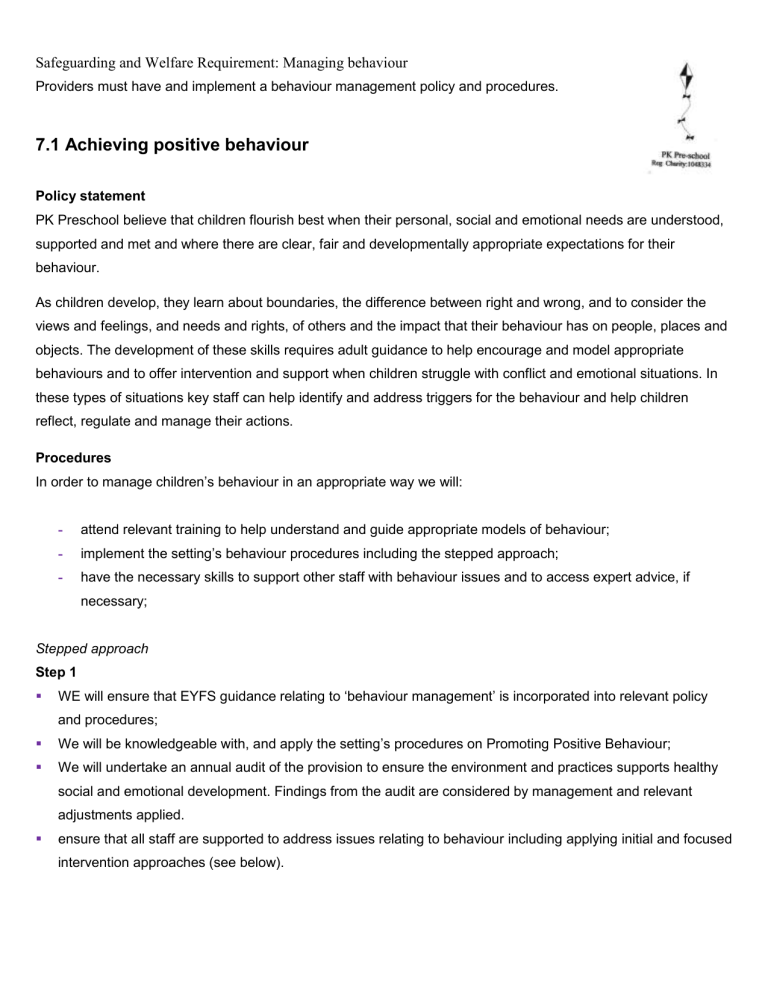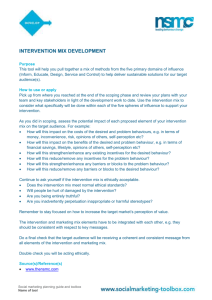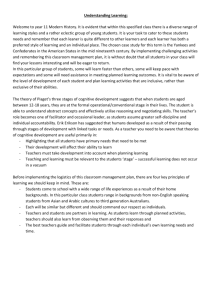7 1 Achieving Positive Behaviour 4 - PK Pre

Safeguarding and Welfare Requirement: Managing behaviour
Providers must have and implement a behaviour management policy and procedures.
7.1 Achieving positive behaviour
Policy statement
PK Preschool believe that children flourish best when their personal, social and emotional needs are understood, supported and met and where there are clear, fair and developmentally appropriate expectations for their behaviour.
As children develop, they learn about boundaries, the difference between right and wrong, and to consider the views and feelings, and needs and rights, of others and the impact that their behaviour has on people, places and objects. The development of these skills requires adult guidance to help encourage and model appropriate behaviours and to offer intervention and support when children struggle with conflict and emotional situations. In these types of situations key staff can help identify and address triggers for the behaviour and help children reflect, regulate and manage their actions.
Procedures
In order to manage children’s behaviour in an appropriate way we will:
attend relevant training to help understand and guide appropriate models of behaviour;
implement the setting’s behaviour procedures including the stepped approach;
have the necessary skills to support other staff with behaviour issues and to access expert advice, if necessary;
Stepped approach
Step 1
WE will ensu re that EYFS guidance relating to ‘behaviour management’ is incorporated into relevant policy and procedures;
We will be knowledgeable with, and apply the setting’s procedures on Promoting Positive Behaviour;
We will undertake an annual audit of the provision to ensure the environment and practices supports healthy social and emotional development. Findings from the audit are considered by management and relevant adjustments applied.
ensure that all staff are supported to address issues relating to behaviour including applying initial and focused intervention approaches (see below).
Safeguarding and Welfare Requirement: Managing behaviour
Providers must have and implement a behaviour management policy and procedures.
Step 2
We address unwanted behaviours using the agreed and consistently applied initial intervention approach. If the unwanted behaviour does not reoccur or cause concern then normal monitoring will resume.
Behaviours that result in concern for the child and/or others will be discussed between the key person, the behaviour coordinator and Special Educational Needs Coordinator (SENCO) or/and committee. During the meeting, the key person will use their knowledge and assessments of the child to share any known influencing factors (new baby, additional needs, illness etc.) in order to place the behaviour into context. Appropriate adjustments to practice will be agreed and if successful normal monitoring resumed.
If the behaviour continues to reoccur and remain a concern then the key person should liaise with parents to discuss possible reasons for the behaviour and to agree next steps. If a cause for the behaviour is not known or only occurs whilst in the setting then the SENCO will suggest using a focused intervention approach to identify a trigger for the behaviour.
If a trigger is identified then the SENCO and key person will meet with the parents to plan support for the child through developing an action plan. If relevant, recommended actions for dealing with the behaviour at home should be agreed with the parent/s and incorporated into the plan. Other members of the staff team should be informed of the agreed actions in the action plan and help implement the actions. The plan should be monitored and reviewed regularly by the key person and SENCO until improvement is noticed.
Step 3
If, despite applying the initial intervention and focused intervention approaches, the behaviour continues to give occur and/or is of significant concern, then the behaviour coordinator and SENCO will invite the parents to a meeting to discuss external referral and next steps for supporting the child in the setting.
It may also be agreed that the Common Assessment Framework (CAF) or Early Help process should begin and that specialist help be sought for the child if deemed necessary – this support may address either developmental or welfare needs. (See Supporting Children with SEN policy 9.2) If t he child’s behaviour is part of a range of welfare concerns that also include a concern that the child may be suffering or likely to suffer significant harm, follow the Safeguarding and Children and Child Protection Policy (1.2).
Advice provided by extern al agencies should be incorporated into the child’s action plan and regular multidisciplinary meetings held to review the child’s progress.
Safeguarding and Welfare Requirement: Managing behaviour
Providers must have and implement a behaviour management policy and procedures.
Initial intervention approach
We use an initial problem solving intervention for all situations in which a child or children are distressed on in conflict. All staff use this intervention consistently.
This type of approach involves an adult approaching the situation calmly, stopping any hurtful actions, acknowledging the feelings of those involved, gathering information, restating the issue to help children reflect, regain control of the situation and resolve the situation themselves.
Periodically the effectiveness of the approach will be checked.
Focused intervention approach
The reasons for some types of behaviour are not always apparent, despite the knowledge and input from key staff and parents.
Where we have considered all possible reasons, then a focused intervention approach should then be applied.
This approach allows the key person and behaviour coordinator to observe, reflect, and identify causes and functions of unwanted behaviour in the wider context of other known influences on the child.
We follow the ABC method which uses key observations to identify a) an event or activity (antecedent) that occurred immediately before a particular behaviour, b) what behaviour was observed and recorded at the time of the incident, c) what the consequences were following the behaviour.
Once analysed, the focused intervention should help determine the cause (e.g. ownership of a toy or fear of a situation) and function of the behaviour (to obtain the toy or avoid a situation) and suitable support will be applied.
Use of rewards and sanctions
All children need consistent messages, clear boundaries and guidance to intrinsically manage their behaviour through self-reflection and control.
Rewards such as excessive praise and stickers may provide an immediate change in the behaviour but will not teach children how to act when a ‘prize’ is not being given or provide the child with the skills to manage situations and their emotions. Instead, a child is taught how to be ‘compliant and respond to meet adult’s own expectations.
Children should never be labelled, criticised, humiliated, punished, shouted at or isolated by removing them from the group and left alone in ‘time out’ . However, if necessary children can be accompanied and removed from the group in order to calm down and if appropriate helped to reflect on what has happened.
Safeguarding and Welfare Requirement: Managing behaviour
Providers must have and implement a behaviour management policy and procedures.
Use of physical intervention
The term physical intervention is used to describe any forceful physical contact by an adult to a child such as grabbing, pulling, dragging, or any form of restraint of a child such as holding down. Where a child is upset or angry, staff will speak to them calmly, encouraging them to vent their frustration in other ways by diverting the child’s attention.
Staff should not use physical intervention – or the threat of physical intervention, to manage a child’s behaviour unless it is necessary to use “reasonable force in order to prevent children from injuring themselves or others or damage property” (EYFS).
If “reasonable force” has been used for any of the reasons shown above, parents are to be informed on the same day that it occurs. The intervention will be recorded as soon as possible within the child’s file, which states clearly when and how parents were informed.
Corporal (physical) punishment of any kind should never be used or threatened which could adversely affect a child's well-being.
Further guidance
Special Educational Needs and Disability Code of Practice (DfE 2014)
This policy was adopted by
On
(name of provider)
(date)
Date to be reviewed
Signed on behalf of the provider
(date)
Name of signatory
Role of signatory (e.g. chair, director or owner)







